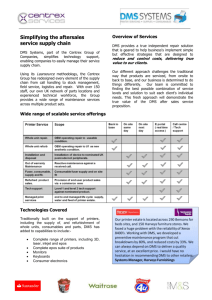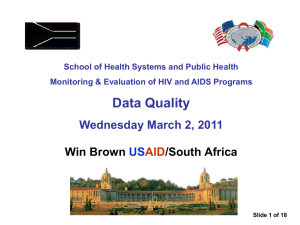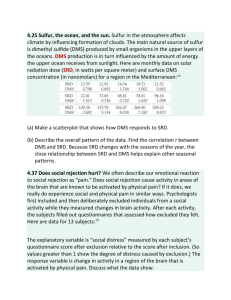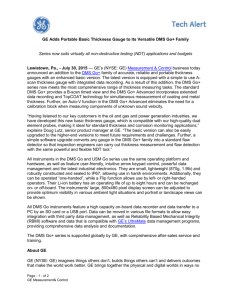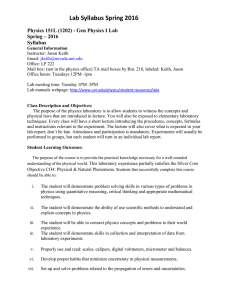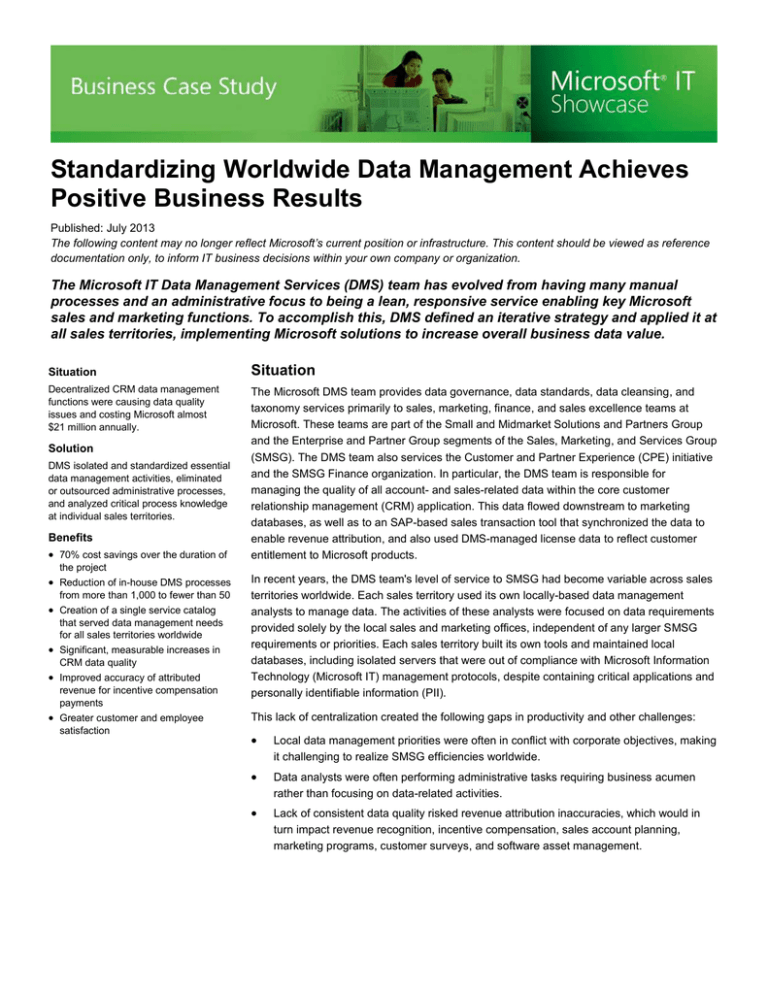
Standardizing Worldwide Data Management Achieves
Positive Business Results
Published: July 2013
The following content may no longer reflect Microsoft’s current position or infrastructure. This content should be viewed as reference
documentation only, to inform IT business decisions within your own company or organization.
The Microsoft IT Data Management Services (DMS) team has evolved from having many manual
processes and an administrative focus to being a lean, responsive service enabling key Microsoft
sales and marketing functions. To accomplish this, DMS defined an iterative strategy and applied it at
all sales territories, implementing Microsoft solutions to increase overall business data value.
Situation
Situation
Decentralized CRM data management
functions were causing data quality
issues and costing Microsoft almost
$21 million annually.
The Microsoft DMS team provides data governance, data standards, data cleansing, and
taxonomy services primarily to sales, marketing, finance, and sales excellence teams at
Microsoft. These teams are part of the Small and Midmarket Solutions and Partners Group
and the Enterprise and Partner Group segments of the Sales, Marketing, and Services Group
(SMSG). The DMS team also services the Customer and Partner Experience (CPE) initiative
and the SMSG Finance organization. In particular, the DMS team is responsible for
managing the quality of all account- and sales-related data within the core customer
relationship management (CRM) application. This data flowed downstream to marketing
databases, as well as to an SAP-based sales transaction tool that synchronized the data to
enable revenue attribution, and also used DMS-managed license data to reflect customer
entitlement to Microsoft products.
Solution
DMS isolated and standardized essential
data management activities, eliminated
or outsourced administrative processes,
and analyzed critical process knowledge
at individual sales territories.
Benefits
70% cost savings over the duration of
the project
Reduction of in-house DMS processes
from more than 1,000 to fewer than 50
Creation of a single service catalog
that served data management needs
for all sales territories worldwide
Significant, measurable increases in
CRM data quality
Improved accuracy of attributed
revenue for incentive compensation
payments
Greater customer and employee
satisfaction
In recent years, the DMS team's level of service to SMSG had become variable across sales
territories worldwide. Each sales territory used its own locally-based data management
analysts to manage data. The activities of these analysts were focused on data requirements
provided solely by the local sales and marketing offices, independent of any larger SMSG
requirements or priorities. Each sales territory built its own tools and maintained local
databases, including isolated servers that were out of compliance with Microsoft Information
Technology (Microsoft IT) management protocols, despite containing critical applications and
personally identifiable information (PII).
This lack of centralization created the following gaps in productivity and other challenges:
Local data management priorities were often in conflict with corporate objectives, making
it challenging to realize SMSG efficiencies worldwide.
Data analysts were often performing administrative tasks requiring business acumen
rather than focusing on data-related activities.
Lack of consistent data quality risked revenue attribution inaccuracies, which would in
turn impact revenue recognition, incentive compensation, sales account planning,
marketing programs, customer surveys, and software asset management.
The team of 36 full-time employees and 164 on-site contractors cost Microsoft almost
$21 million annually.
Meanwhile, due to advances in network, server, and application technologies, the rate of data
collection increased rapidly. To keep pace with data collection and to optimize data quality,
Microsoft IT required a scalable method of standardizing its data management practices and
resolving the productivity issues created by years of decentralized operations.
Figure 1. DMS standardization project stakeholders
Solution Summary
Beginning in October 2008, the DMS team conducted a five-month analysis of existing
worldwide data management operations. New time tracking processes gathered details about
the activities that employees and analysts in each sales territory conducted. Using the results
of this analysis, a clearer picture of the problem space emerged: the team now understood
more about the tools and systems in use, the roles that workers played in each sales
territory, and the division between data- and business-related tasks.
Following the analysis period, the team delivered a strategy consisting of four main objectives
in all sales territories:
Deliver a consistent set of services within a specific service catalog.
Rationalize and automate core processes, including scaling to off-shore resources.
Drive improved data quality standards and territory-based operational governance.
Document individual workers' unique data management process knowledge.
Standardizing Worldwide Data Management Achieves Positive Business Results
Page 2
Figure 2. DMS enterprise support strategy
Solution Components
This section describes in further detail how the sales, marketing, finance, and sales
excellence teams implemented the key DMS objectives.
Delivering Services Within a Service Catalog
The service catalog concept describes a portfolio of services exclusively provided by a single
team. In this case, the DMS team required a process for determining, managing, and
executing against a service catalog that both provided an exhaustive range of data
management services, and was globally consistent, meaning that all local DMS personnel
were using the same service catalog regardless of their geographic location. This
consistency, together with a plan to periodically review and update the catalog as needed to
serve new business needs, provided a more stable basis for the service expectations that the
DMS and business unit teams could share.
To determine the service catalog, the DMS team followed three key steps:
1.
The DMS team collected information on the services that team provided, starting with a
single DMS sales territory that had recently achieved organizational independence from
its local Global Marketing Operations (GMO) counterpart.
2.
The DMS team generated a scope statement for the purpose of determining what
existing processes would be retained. (The details of this activity are described in the
next section, "Rationalizing and Automating Core Processes.")
3.
The DMS team began scheduling meetings to begin preparing local personnel for clearer
worldwide service alignment, including planning the changes that were likely to impact
the local teams.
The main team members directing this effort were thought leaders within the regional DMS
teams. Later in the project, a centralized planning function was put in place. Corporate DMS
owned a stake in the solution, but was not active in starting the project. Years-long
Standardizing Worldwide Data Management Achieves Positive Business Results
Page 3
inefficiencies resulted in reduced visibility of critical issues, impairing support and guidance at
the corporate DMS level.
As with all areas of the solution, communication played an important role throughout the
research and implementation phases of this objective. The new time tracking processes gave
the team an understanding of the range of effort and demand at each location, and allowed
them to relate the likely impacts of the solution to the sales territory personnel early on.
The service catalog model took approximately three years to mature. Each year brought
further aggregation of similar services into a smaller set of scope-bound offerings. This
duration was due to the need for some critical local services to remain in operation until the
team could devise more centralized work-arounds. As the individual service catalogs were
combined into a single catalog, the DMS Planning Lead maintained the growing document as
a spreadsheet file. The DMS Planning Lead also sent regular updates to the corporate DMS
team, corporate business segment leads, and business managers within the sales territories.
Mitigating the Risk of Business Dissatisfaction
The key risk to implementing this solution was dissatisfaction among business units in each
sales territory who feared that the proposed changes would lead to a decline in
responsiveness to their data-related needs. To achieve their sales targets, these businesses
were accustomed to providing requirements directly to their local DMS teams. Centralizing to
a single DMS service catalog caused many stakeholders to fear a loss of support for, and a
loss of control over, their unique data management activities. Similarly, the existing
perception that each DMS was an extension of the local business, rather than a part of a
centralized global function, created a loyalty of each DMS team to the specific demands of its
business customers.
To repair the fragmented DMS model while mitigating the risk of dissatisfaction or dysfunction
on the sales territory level, the DMS team established three goals:
Working closely with each business unit to determine sustainable, scalable service level
agreements (SLAs).
Focusing on outcomes by demonstrating to business personnel that the solution can
follow alternate, unified methods to achieve the same results as preexisting models.
Communicating a purposeful message about the holistic benefits of the solution to the
larger SMSG organization. A higher level of integration yields greater maturity of data
management processes and increased predictability of results across sales territories.
Best Practices
Along with the overall best practice of tracking data management activities to a single service
catalog, the team followed other best practices to achieve positive results:
Pursuing a thoughtful engagement model that accommodated business unit input while
emphasizing the need for standardization. This model allowed multiple sales territory
DMS and business leads to provide timely planning input.
Continuing all time tracking processes in order to track performance-related data. Using
these tracking processes together with the newly unified service catalog supports a
better informed service management capability and clearer long-term planning for the
DMS team.
Implementing organizational changes to reflect the newly unified service structure,
including the centralization of a core team to manage services in the service catalog.
Standardizing Worldwide Data Management Achieves Positive Business Results
Page 4
Aggregating similar services into service lines and automating each line's activities.
Implementing a support model for the new solution based on the same charter and
mandate as the solution itself.
The other solution objectives described in this case study provide further details about how
these best practices were implemented by the DMS team.
Rationalizing and Automating Core Processes
From the start, the DMS team knew that fixing the inefficiencies in the existing data
management model would require automating as many processes as possible. However,
early analysis led to the discovery of more than 1,000 individual ongoing processes being
performed at the DMS locations, making automation extremely difficult. To make DMS
unification a success, the team undertook a conscious effort to rationalize these disparate
processes and make rigid determinations about which ones were necessary moving forward.
One of the first decisions was to limit the scope of DMS processes to those that directly
benefitted data management. If a process or activity did not match this criterion, it was
classified as out-of-scope. Several fundamental processes, such as those required for
revenue attribution, were determined to be in scope due to their common requirement of
DMS success in all territories. All other activities were evaluated, and most—including
processes that directly served the business units rather than the data itself—were eliminated.
To lead these evaluation efforts, the DMS team formed a capability team consisting of DMS
leads from the various sales territories and other subject matter experts in the data
management area. Together, this capability team performed the following steps to achieve
rationalization and automation:
1.
Collected processes and descriptions from all sales territories.
2.
Conducted in-person interviews with DMS personnel to understand the importance of
each process.
3.
De-duplicated the processes where redundancies were found in order to reduce the
overall process count.
4.
Selected the most mature automation platform among the sales territories in terms of
suitability for automation, and used it as a basis for testing process automation.
5.
Expanded the trial automation platform to include other sales territories in its scope.
6.
Moved manual processes into the new automated workflows until all processes capable
of automation had been included.
Over six months, from October 2008 to March 2009, this rationalization and automation took
the number of DMS processes from over 1,000 down to a current number of 47 processes in
eight functional areas. The initial DMS service catalog comprised these 47 processes.
Best Practices
The main risks of this exercise were the potential loss of knowledge and expertise through
the elimination of processes, and the alienation of business units that were concerned about
the perceived change in their levels of service. The DMS team used the following best
practices to mitigate these risks:
Standardizing Worldwide Data Management Achieves Positive Business Results
Page 5
Arranging sales territories into subgroups based on business model commonalities,
identifying the roughly 70 percent of all processes early on that contained areas of
overlap due to these commonalities, and focusing elimination and consolidation efforts
on the remaining 30 percent that were exception-driven and territory-specific.
Offering longer-term contracts to key resources whose talents or expertise were useful to
the simplification process.
Including engagement managers from the business units who could communicate
rationale and readiness to business users regarding the changes to their familiar data
management activities on the capability team.
In addition to these best practices, the DMS team pursued a "single vendor" goal in order to
reduce the number of DMS contracts and centralize knowledge strategically with one trusted
service provider. This provider would conduct all data management tasks in the service
catalog; all remaining administrative tasks would be performed outside of DMS in Microsoft
Data Operations Center (DOC) facilities located in India, China, and Poland.
Edge Case: Integrating the US Subsidiary
Applying the DMS solution to the US sales territory presented unique challenges. US
business rules regarding mergers and acquisitions, bankruptcies, holding companies, and
other legalities were particularly complex, and the data management vendor in place at the
US sales territory had special knowledge and processes related to these complexities. Many
of these processes were not scalable and prevented the adoption of corporate tools. In
addition, long dispute resolution cycles and poor data quality created a unique challenge
when integrating the US sales territory into the DMS solution. For these reasons, moving the
US sales territory from a dedicated vendor model to become part of the new worldwide model
required a customized strategy.
To maintain the precision and quality of data management services provided by the vendor,
the DMS team chose to retain the incumbent vendor for a period of time during the transition
to the worldwide model. Although this decision created a temporary anomaly within the larger
unification project, the team decided that managing the US DMS transition separately was
the safest choice, given the risk to operational and data quality posed by eliminating the
vendor altogether.
The customized strategy yielded positive outcomes:
Customer and partner data management processes, business rules and tools were
aligned between the US sales territory and worldwide SMSG.
New, intuitive self-service user interfaces enabled US workers to take more data
ownership.
Simplification and automation reduced operational costs.
Service Level Agreements (SLAs) were reduced from 21 days to 3 days, due In part to a
simplified approval process and faster response times.
As DMS rationalization and automation activities proceeded in the US sales territory, the
vendor was included in the capability team's discussions, and special care was taken to
document the vendor's unique knowledge of US DMS operations. When a single-vendor
model for all DMS operations was established in July 2012, the vendor was invited to
compete for the DMS business, and won the contract for all DMS operations worldwide. A
key factor in winning this business was the vendor's proposal to create a managed service
Standardizing Worldwide Data Management Achieves Positive Business Results
Page 6
whereby it performed all day-to-day operations on its own, changing scope and scale as
needed to meet changing SMSG criteria and requirements.
Driving Data Standards and Territory-Based Governance
In the same way that sales territories were following disparate workflows according to local
requirements, they were also disparate in their methods of collecting and formatting CRM
data. Data quality was highly inconsistent due to this fact. Also, within and across territories,
the same CRM schema elements were being used to collect different kinds of information.
Duplicate customer entries were plentiful in the CRM system, and many cases of incorrectly
recorded revenue were discovered.
The DMS team felt strongly that the key to restoring a consistently high data quality was a
governance plan that had buy-in from all sales territories. The plan had the following tenets:
All DMS activities must follow uniform data quality and formatting standards.
Individual territories must be accountable for maintaining adherence to the new
standards.
Dirty, or problematic data must be eliminated, and clean, usable data must be
maintained.
Enforcing this plan entailed shutting down existing processes in which sales and marketing
personnel were permitted to enter or change data on their own, instead routing those
processes to DMS personnel using the new workflows. This change caused concern within
many of the business units impacted by the DMS solution. To respond to this change, and to
communicate the value of the new workflows, the DMS team emphasized that both they and
the businesses shared a need for the same favorable outcomes—high data quality and
accurate revenues—and as long as these outcomes were achieved, the new workflows and
governance model would be a success.
Documenting Unique Process Knowledge
The organizational changes brought on by the DMS solution meant that some data
management personnel, locally selected vendors in particular, would no longer perform their
existing roles. Those personnel who kept their roles were likely to be transitioned to new
duties and workflows. These changes, along with the process of engineering a new
standardized DMS workflow overall, required that the DMS team rigorously capture the
unique process knowledge that was vital to understanding data management operations in
each sales territory.
This knowledge capture entailed three repeated processes at each local DMS site:
Interviewing DMS personnel about the activities they performed.
Documenting why and how each activity was performed, and what other activities it fed
into.
Verifying the importance of each activity by reviewing its triggers and outcomes in the
larger local DMS process.
To differentiate important knowledge from trivial details that would have little or no bearing on
the new model, the subject matter experts on the DMS capability team conducting the
analysis made determinations as they went along. Some fundamentally important processes
were identified up front; for all others, the team scheduled daily triage meetings to assess
details and rank their importance. When a programmatic fix was required in order to align a
Standardizing Worldwide Data Management Achieves Positive Business Results
Page 7
critical process with the new model, the team used agile methodology to implement changes
where needed.
Best Practices
Three best practices played key roles in this objective:
Identifying key talents among the local DMS personnel and engaging those personnel in
designing the new solution.
Creating a readiness plan for the new workflows, with the flexibility to reduce or simplify
the organization, thus avoiding the loss of vital local knowledge.
Maintaining a drive toward high-quality data and processes, focusing on the full
elimination of data and process defects.
Results
The DMS strategy overhaul achieved all characteristics of a successful program. The
overhaul started with a plan as a response to budget pressures. Executors adhered to the
plan throughout its duration, remaining clear about its key objectives and communicating
those objectives consistently during the execution phase. Four years later, the DMS
organization continues to benefit from the improvements that were implemented.
In addition to reducing the number of DMS processes from more than 1,000 down to fewer
than 50, the success of standardizing these processes has reduced DMS costs by 70
percent. The move from having disparate subsidiaries to having a single DMS made it
possible to integrate DMS resources and provide service against a true unified service
catalog. Both integrating DMS resources and leveraging a unified service catalog were not
possible under the previous model. Today, a single Planning Lead role now maintains all
DMS planning and the automation that is enabled by the service catalog. The DMS team also
consolidated 16 applications running independently at different sales territories into a single,
unified data platform over a two-year period.
Recent auditing for fiscal year 2013 has shown that DMS efforts have had measurable
impacts, as shown in Figure 3.
Figure 3. Impacts of DMS efforts
In addition to doing more with less at lower costs, these efforts have also resulted in higher
net satisfaction ratings from internal customers. Microsoft uses a net satisfaction index to
Standardizing Worldwide Data Management Achieves Positive Business Results
Page 8
quantify users' satisfaction with Microsoft over time. The formula for net satisfaction is derived
from a response to a single question, as shown in Figure 4.
Figure 4. Calculating net satisfaction at Microsoft
Before these efforts were conducted, DMS net satisfaction scores ranged from 90 to 101.
The latest assessment shows continuing net satisfaction improvement and a current score of
139. As net satisfaction increases, two other key impacts are felt. First, employee satisfaction
also increases, because workers feel more confident about their jobs. Second, costs go down
further, as processes continue to be streamlined and automated.
The DMS team has developed repeatable best practices across the sales territories and
driven maturity and standardization in the worldwide data management model for the
company. These innovations have enabled the creation of new tools, such as the DMS
Service Request Tracking Tool, used for reporting and escalating issues to relevant local
DMS teams.
At Microsoft, as in many large companies, the corporate sales function is often considered
the voice of the business. DMS efforts to streamline its worldwide processes have resulted in
going from many voices to one.
For More Information
For more information about Microsoft products or services, call the Microsoft Sales
Information Center at (800) 426-9400. In Canada, call the Microsoft Canada Order Centre at
(800) 933-4750. Outside the 50 United States and Canada, please contact your local
Microsoft subsidiary. To access information via the World Wide Web, go to:
http://www.microsoft.com
http://www.microsoft.com/technet/itshowcase
© 2013 Microsoft Corporation. All rights reserved.
Microsoft, Windows, and Windows Server are either registered trademarks or trademarks of
Microsoft Corporation in the United States and/or other countries. The names of actual
companies and products mentioned herein may be the trademarks of their respective
owners.
This document is for informational purposes only. MICROSOFT MAKES NO WARRANTIES,
EXPRESS OR IMPLIED, IN THIS SUMMARY.
Standardizing Worldwide Data Management Achieves Positive Business Results
Page 9

